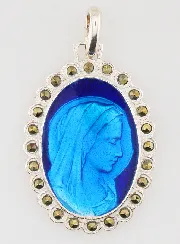Blue, often associated with the Virgin Mary, is one of the most symbolic and richly significant colours in sacred art and Christian tradition. The choice of this colour to represent the Mother of God is not just aesthetic, but deeply rooted in history, theology and religious symbolism.
Blue: the colour of heaven and divinity
Blue is above all the colour of heaven, and in the Christian tradition, heaven symbolises the divine realm, the infinite, and spiritual elevation. Wearing blue for the Virgin Mary underlines her role as mediator between heaven and earth, between humanity and God. As the Mother of Christ, she is the one who gave flesh to the Incarnate Word, making the link between the divine and the earthly world. Blue recalls this closeness to God and her special vocation, which elevates her above other creatures while keeping her close to humanity.
Purity, loyalty and fidelity
Blue is also a colour that symbolises purity, loyalty and fidelity. In the medieval and ancient imagination, blue was often reserved for those who possessed exceptional moral qualities. When applied to the Virgin Mary, blue evokes her immaculate purity, as she is "full of grace" and without sin. Her exemplary life of faith, devotion and fidelity to God is magnificently reflected in this colour. By wearing blue in artistic representations, Mary is seen as the perfect model of faith, faithful to her divine mission and loyal in her commitment to God's purpose.
Nobility and royalty
In the Middle Ages, blue also became the colour of royalty and nobility. Blue pigments, particularly azure and ultramarine, were extremely expensive, as they were obtained from the precious stone lapis lazuli, imported from as far away as Afghanistan. This reinforced the association of blue with the sacred and prestigious. Mary, often depicted as Queen of Heaven, is symbolically dressed in blue to show her royal status as Mother of Christ the King. This choice recalls her dignity and greatness, not only as a mother, but as Queen of Heaven and Earth.
Compassion and peace
Blue, with its calm and soothing tones, also embodies peace, tranquillity and compassion. Mary is seen in Christian tradition as a motherly figure, full of tenderness and mercy. She is the one who intercedes for souls, who comforts and brings peace to those who turn to her. This association between blue and peace is also echoed in prayers invoking Mary under the titles "Our Lady of Peace" or "Queen of Peace". Blue, in this sense, becomes a symbol of the inner peace that Mary can bring to those who suffer or seek refuge under her protection.
A connection with water and life
Blue, the colour of water and oceans, also symbolises life, regeneration and baptism in the Christian faith. Water is a fundamental element for physical life, but it is also a powerful image of spiritual life. Baptism, which uses water to symbolise the cleansing of sins, is a gateway to the Christian life. Mary, as the Mother of Jesus, plays a crucial role in this new life offered to humanity through her Son. Blue, representing water, life and spiritual rebirth, reflects this dimension of Mary as a source of spiritual life and hope.
Divine Motherhood
Marian blue is also closely linked to Mary's divine motherhood. Her ability to give birth to Jesus Christ, the Son of God, places her in a unique position in salvation history. The blue thus connects her to the mystery of the Incarnation, where the divine takes flesh through her. This underlines her role in the economy of salvation and makes her the first and most perfect of Christ's disciples.
Symbol of humility and simplicity
Although blue is a royal and divine colour, it is also a symbol of humility and simplicity in representations of Mary. The greatest divine mysteries are often revealed in simple, humble realities. Mary, in her total humility, accepts God's will with a pure and obedient heart. Blue expresses this inner disposition: a greatness that does not seek to show itself but radiates through simplicity and faith.
A universal and timeless colour
Finally, blue is a universal colour, present in nature from the sky to the oceans, and its spiritual significance crosses eras and cultures. It is a timeless colour that continues to resonate deeply in the hearts of believers. It links Mary to the universal, because her role as Mother is not limited to one people or one era, but she is the Mother of all humanity, always ready to intercede and protect her children.
Conclusion
The blue of the Blessed Virgin Mary is a rich symbol, evoking at once her purity, her royalty, her closeness to God and her role as Mother of humanity. It is a colour that has carried a message of peace, fidelity and hope for believers down the centuries. Every time we contemplate an image of the Virgin Mary dressed in blue, we are invited to reflect on her virtues and the infinite love she shows for all those who turn to her. Blue is therefore much more than just a colour: it is a bridge to the mystery of faith, compassion, and the promise of eternal life in God.




















